THE American WESTERN
By Jeffrey-Baptiste Tarlofsky
By Jeffrey-Baptiste Tarlofsky
Lesson 20 consists of 6 video lectures and transcripts of those lectures, and 5 film excerpts. Start with the lecture, Part 1 and continue down the page in sequence until you reach the end of the lesson.
レッスン20は、6本のビデオレクチャー(レクチャーのテキストがビデオレクチャーの下に記載されています)と5本の動画で構成されています。
このレッスンは、最初のLecture Part 1から順番に動画を見たりテキストを読んでください
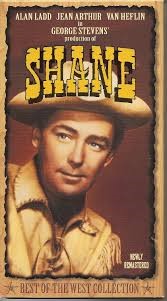
Directed & Produced by: George Stevens
Screenplay by: A.B. Guthrie Jr and Jack Sher
Based on: Shane 1949 novel by Jack Schaefer
Starring: Alan Ladd, Jean Arthur, Van Heflin, Brandon deWilde, Jack Palance
Music by: Victor Young
Cinematography: Loyal Griggs
Running time: 118 minutes
Part 1 – Everyone, farmers and cowboys alike, is celebrating American Independence Day on the Fourth of July. July 4, 1776, was the day on which the Declaration of Independence gave birth to the United States of America as an independent nation. But it is also the tenth wedding anniversary of the Starretts, and their neighbors want to help them celebrate this event as well. In Stagecoach I remarked that just when we most expect Ringo to kiss Dallas he tells her to “wait here” and goes off to fight the Plummer brothers. In contrast, the young lovers in Red River, Tess and Matt, passionately kiss in the rain the first day they meet. But the Starretts are not young lovers. They are probably meant to be in their mid-thirties (if we assume they were in their early- to mid-twenties when they got married, which was the normal age for men to marry, though women usually married in their late teens or early twenties).
Some marriages are like good wines, they get better with age. The Starretts are clearly as in love with each other now as they were ten years ago when they married. But as the dancing continues Shane and Mrs. Starrett dance together and we cannot help but notice (just as Joe notices) that they are by far the best dancers at the party…and that they make a handsome couple. Again, nothing at all is said about this. But we see it, and so does Joe.
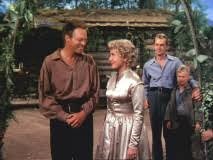
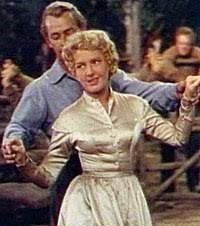
Following the dance, Torrey tells everyone about seeing “a stranger decked out like a gun fighter” in town, but says he didn’t let him scare him. Shane warns the farmers that there is a gunfighter who fits the description Torrey gave and to be careful (more foreshadowing). One of the farmers notes that Shane seems to know a lot about gunfighters. He adds that “murder” would be a more accurate word for what gunfighters do. That was probably mostly true, but we have also learned that it wasn’t just gunfighters who committed murders. The Plummer brothers were ranchers just like Ringo’s father and they were murderers. The Cleggs clan in Wagon Master were not gunfighters in any true sense, they were just a gang of criminals. On the other hand, we have seen that someone like Mathew Garth might be a very fast with a gun, a “gunslinger”, but by no means a murderer. We know Shane is a gunfighter (gunslinger), but we don’t know much about his past and what he might have done, though we have had a hint of what he is capable of when we saw him shoot the white rock for Joey.
Part 2 –This is a very important scene in the film. At one point in the negotiations Riker appeals directly to Joey, asking him what he thinks. It may be a clever psychological tactic by Riker, but it is also an interesting choice by the director, George Stevens. Stevens has made Joey the witness who sees almost all the important events in the film. Joey is our eyes and ears as the story unfolds. But it is important to note just how Joey sees things. Joey is eight-years-old and to an eight-year-old the world is divided into good guys and bad guys, white hats and black hats. Joey’s father and Shane are clearly the “white hats” in his eyes, while the Rikers have been the “black hats” ever since he and his family arrived in the valley. But suddenly, Riker is off his horse and actually looking up at Joey and speaking to him in a soft voice and using simple language that Joey can understand.
He is acting as if he were the “white hat”. In fact, Riker is acting the same way toward Joey that Shane has acted and Joey doesn’t know how to respond to this sudden change in Riker. But Riker is doing the same thing with us in the movie audience. He is making an appeal to us as well. The key moment is when Mr. Starrett says, “…and us in the right all along”. Riker is genuinely surprised and indignant about this. “You in the right?”. That just isn’t how he sees it. Note how George Stevens films Riker at this moment. He sits straight in his saddle and the camera is looking up at him with the sky behind him. He looks strong and noble and he proceeds to give a strong and noble account of himself and what he has done. He starts by reminding Starrett that he came to the valley when Starrett was Joey’s age. This must be twenty-five year ago at least, which would mean that Riker arrived in the valley probably just after the Civil war or around 1865, just as Western settlement was starting. The valley would certainly have been part of Indian hunting land and just as Riker says, the Indians would have fought ferociously for the land.
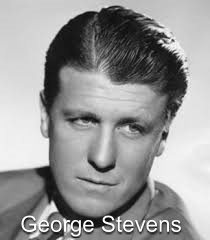
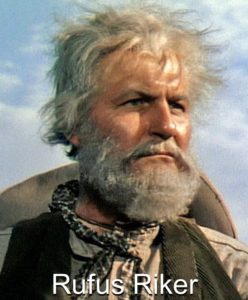
In fact, Riker’s story is remarkably similar to that of Thomas Dunson in Red River. Dunson also fought Indians and cattle rustlers and others who tried to take his land and in the end he built a great ranch. Both men are intensely proud of their accomplishments, but what they accomplished took place during very different times and in different places. Dunson built his cattle empire in the Texas of the 1850s and early 1860s, while Riker built his empire in Wyoming from the mid-1860s through the 1880s. It is only one generation of difference and in all human history hardly “a drop in the bucket” as the saying goes. But in the history of the West, this difference is huge because the history we are talking about begins in 1865 and ends in 1890. Dunsons’ story takes place at the very beginning of the settlement of the West while the events in Shane are taking place at the very end of that history. Riker is absolutely correct when he says the Indians and rustlers don’t bother Starrett and the other homesteaders because he and the men of his generation “handled them”. It was Riker who changed the valley and made it safe and so, in his time, Riker might be seen as the “white hat” in the story. That is exactly what George Stevens is giving Riker a chance to say in this scene: “Wait a minute! I am the hero in this movie! Just listen to what I have done!”
Joe Starrett does listen and he hears Riker out respectfully and says he does appreciate what Riker and his generation accomplished, But the times have changed. In fact, this is one of the most important themes in Western films, the speed with which things changed. Twenty-five years is not a full lifetime, but it is enough time for a young man like Starrett to become an old man like Riker. One generation must give way to the next, just as we saw in Red River when Matt took over the cattle drive from Dunson. And just like Thomas Dunson, Rufus Riker is not willing to step aside and let the younger generation take over. He has his pride. If Western men had one thing, it was their stubborn pride.
But history doesn’t care about a man’s pride. History simply rolls on and in the West it rolled very fast. New people were constantly moving west and conflict was inevitable. We have already said big ranchers fought small ranchers, cowboys fought sheep herders, and in Shane, ranchers and cowboys are fighting with farmers. Rufus Riker and his cowboys represent the romantic figures who tamed the Wild West, but their time is largely passing. In taming the Wild West, they made it safe for others like the farmers to come and settle there. The new comers are not men looking to escape from their past or seek adventure, they are men with wives and children who are bringing civilization to the Wild West.
Reading Only
Here is the entire exchange between Riker and Starrett. By reading it, you get an even greater sense of just how much George Stevens is allowing Riker to present his case.Rufus Ryker: I had somethin’ I wanted to talk over with you, Starrett.
Joe Starrett: Whatever business you and I got, we can talk over right here.
Rufus Ryker: I’ll just lay it on the barrel-head then. How would you like to work for me?
Joe Starrett: I’m workin’ for myself. I’ve done enough workin’ for others.
Rufus Ryker: Wait till I tell ya: I’ll pay ya top wages, more than you can make on this patch of ground.
Joe Starrett : Nope. I’m not interested.
Rufus Ryker: I haven’t said it all. You can run your cattle with mine. What’s more, I’ll buy your homestead. Set a price you think is reasonable, you’ll find me reasonable. Is that fair?
Joe Starrett: You’ve made things pretty hard for us, Ryker, and us in the right all the time.
Rufus Ryker: Right? You in the right? Look, Starrett, when I come to this country, you weren’t much older than your boy there. We had rough times, me and other men that are mostly dead now. I got a bad shoulder yet from a Cheyenne arrowhead. We made this country. Found it and we made it. With blood and empty bellies. The cattle we brought in were hazed off by Indians and rustlers. They don’t bother you much anymore because we handled ’em. We made a safe range out of this. Some of us died doin’ it but we made it. And then people move in who’ve never had to rawhide it through the old days. They fence off my range, and fence me off from water. Some of ’em like you plow ditches, take out irrigation water. And so the creek runs dry sometimes and I’ve got to move my stock because of it. And you say we have no right to the range. The men that did the work and ran the risks have no rights? I take you for a fair man, Starrett.
Joe Starrett: I’m not belittlin’ what you and the others did. At the same time, you didn’t find this country. There was trappers here and Indian traders long before you showed up and they tamed this country more than you did.
Rufus Ryker: They weren’t ranchers.
Joe Starrett: You talk about rights. You think you’ve got the right to say that nobody else has got any. Well, that ain’t the way the government looks at it.
Rufus Ryker: I didn’t come to argue. I made you a fair proposition.
Joe Starrett: What about the others?
Rufus Ryker: Shane already knows he can work for me anytime.
Joe Starrett: The other homesteaders.
Rufus Ryker: Look, be reasonable! After all, there’s just so many hands in a deck of cards.
Joe Starrett: Then I’ve got to say no.
Rufus Ryker: You don’t give a man much choice do you, Starrett?
OH, BY THE WAY, HAVE YOU FIGURED OUT WHAT THE OLD TREE STUMP SYMBOLIZES YET? IF YOU HAVEN’T FIGURED THAT OUT YET, GIVE IT SOME MORE THOUGHT BEFORE GOING ON TO PART THREE.
Part 3 – In Stagecoach, John Ford showed his audience the negative side of this “civilization” that was taking over the West. The ladies of the Law and Order League represent that civilization and they force Doc and Dallas out of the “civilized” town they control. There is no place for drunks, outlaws or prostitutes in their town. But in Stagecoach there was still enough time and space for Dallas and Ringo to go West and start new lives “safe from the blessing of civilization” as Doc ironically says. Stagecoach was set in about 1881. A mere eight or so years later it is too late to go further west…there isn’t anywhere left to go. Rufus Riker has no intention of leaving the valley he tamed. Why should he? He believes that the range should be “open” and no “sod buster” (farmer) has the right to fence any of it off for himself or to fence Riker off from the water his cattle need.
Like Thomas Dunson, Rufus Riker has spent his whole life settling disputes with a gun. But he is remarkably hesitant to resort to violence against Joe Starrett. There is just the slightest suggestion that Riker admires Starrett and sees something of himself in the younger man. When Riker tells little Joey he doesn’t want “trouble” with his father he is being absolutely sincere. This is why he offers Starrett what he calls a “fair offer”…to buy his land and pay him a good wage. It is actually quite a bit better than a “fair” offer, it is generous. But Riker is also cunning. He knows that if he can get Starrett to give up his homestead, it will be easy to get rid of the other homesteaders at no cost. Starrett knows this, too. He could take the deal and profit from it, but Riker was right to see a little bit of himself in Joe Starrett, because Starrett has the exact same stubborn pride Riker has. He refuses the offer because doing so would be disloyal to the other homesteaders, it would be dishonorable. The one thing Westerners were most stubborn and proud about was their honor. It was worth dying for.
In this conflict, both sides have good arguments and legitimate claims. The conflict between Starrett and Riker is not a really a “black hat” vs “white hat” one, but simply a question of who has the best legal argument. Today arguments such as these are settled by the two parties going to a court of law where a judge rules based on who has the best legal claim. That is how civilization works. But in this place there are no courts, judges or even law men as of yet. It is still the Wild West, at least for a time. Civilization is just starting to take hold here. While Riker genuinely does not want to use violence against Starrett and the other homesteaders, he is becoming desperate.
It was Shane who shifted the balance of power when he came into the valley, first by standing by Starrett when Riker tried to intimidate him and then by beating Chris Calloway in the saloon fight, and then by beating the Rikers and their cowboys with Starrett in the second and more terrible fight. In that fight, Shane showed Starrett and the other homesteaders that Riker and his men could be defeated. Riker’s response has been to “up the ante” by bringing Wilson into the valley.
As Starrett and Riker negotiate, Shane and Wilson silently “size each other up”. Again, nothing is said, but everything is understood between the two men. Each knows what the other is. Wilson is there with the Rikers as an implied threat of what will happen if the offer is turned down. Riker has not said why Wilson is with them, but there is no mistaking what Wilson is. As Shane says, “he’s no cow puncher (cowboy), that’s for sure”. In the next excerpt we shall see just exactly what Wilson really is.
Part 4 – I cannot think of any American Western (even the comedies) that does not include scenes of violence. Of course, today, films show limitless violence. Arms, legs and heads are blown off, people are eaten alive by dinosaurs, they explode from inside when alien hosts emerge, they are slowly swallowed by anacondas or quickly eaten by each other in zombie movies.
My theory about why people watch this stuff is that it is like going on a jet coaster ride at the amusement park. Even though the ride seems dangerous, we know it isn’t really dangerous. We are just having fun. When we watch the violence in movies today we all know (or should know) these things are not real. But audiences were very different in 1953. In 1934, Hollywood came up with a set of rules known as The Production Code, which we have already talked about. It was the Production Code that prevented John Ford from using the word “prostitute” in Stagecoach even though Dallas was clearly a prostitute. It was the production code that prevented the gay love story in Red River from being more open than it was. But in both films, you can understand what is really going on if you “read between the lines” (understand what is not being said). Maybe another reason my Japanese students enjoy these Westerns so much is because they are so good at “reading between the lines”.
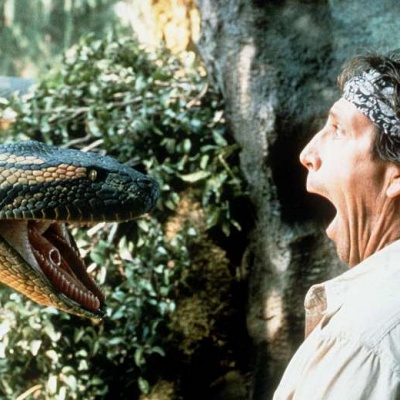
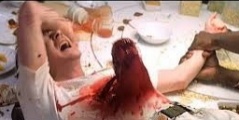
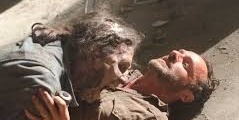
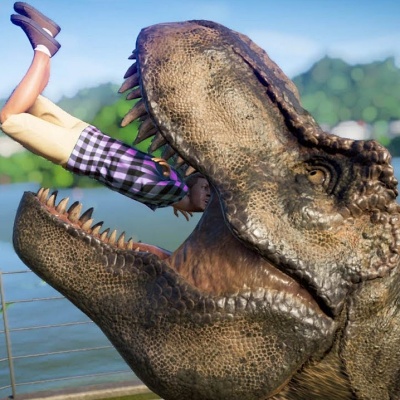
The same rules applied to violence. The production code actually forbade the depiction of torture, mutilation or severe bodily harm. Yet, Hollywood films after 1934 are still quite violent. However, the violence is often suggested, masked or stylized. Just as we know Dallas is a prostitute in Stagecoach, we also know Ringo shoots and kills the three Plummer brothers at the end of the film, even though we don’t see him actually do it. It does seem odd that Ford should be squeamish about showing the final gunfight when he had no problem showing Ringo and the other passengers killing about two dozen Indians during the chase scene. But, those were Indians being killed! There was a double standard. Violence committed by or against Indians (or other racial minorities) was more tolerated. Remember how racist Hollywood (and America) was (e.g., the Production Code forbade the depiction of any romantic relationships between Blacks and Whites).
So, violence was always part of Western films, but it was very mild by our standards today. When shot, a man would grasp the wound and grimace, but we never saw the blood. Well, almost never. In all the films we have seen in this class there has only been one scene in which we have seen blood, the scene of Mr. Peacock being shot by an arrow. Ford broke the rules when he showed the blood, but he got away with it partly because it was an Indian arrow (remember; violence by or against minorities was more acceptable) and partly because he was John Ford and he was allowed to break the rules because of his high status in Hollywood.
George Stevens has a very different approach to violence than any of our other directors so far (even Arthur Penn in The Left handed Gun). For example, the scene in Red River, in which Thomas Dunson, Matt and Cherry kill the three cowboys who want to quit is quite terrible. I mean, it is a terrible thing that is being done …but even while we see all three men killed on screen, we really don’t see them very clearly. They are mostly in shadow. It is still a very violent scene, but it doesn’t come close to what George Stevens does in Shane.
We have already said that Stevens understood that while audiences were entertained by a certain level of violence, they would be upset if it went too far. I am talking about the audiences of 1953 who were not used to seeing violence. When Shane and Chris Calloway fight it is very violent, but it is entertaining (Joey eats his candy while watching it). But then Stevens takes the violence to a new level when Shane is being beaten by the six men all at once. We react to this just as Joey reacts. it upsets us and we want it to stop (at least that was how audiences reacted in 1953).
In the scene in which Wilson kills Torrey, there is a long, slow build up to the moment of violence. Stevens has already foreshadowed this event in earlier scenes. The sound of thunder is heard as Torrey and Shipstead ride into town and Victor Young’s music becomes dark and foreboding. We know Torrey is quick to anger and Wilson knows this, too. Shipstead tells Torrey, “I wouldn’t go over there” but Torrey is like a child who will not listen to his mother. Shipstead tries to call him back three times; the first time he calls in a neutral voice, the second time in a slightly pleading voice, and the third time in a questioning voice…but then it is too late. Torrey is now up-close facing Wilson who keeps his eyes on Torrey throughout the encounter like a cobra hypnotizing a rabbit before it strikes.
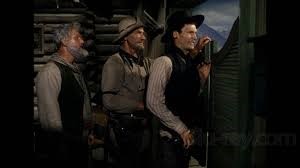
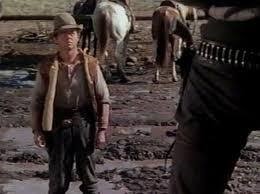
Wilson is above Torrey walking on the wooden sidewalk in front of the store eventually climbing steps which place him towering over Torrey. Then, with slow careful movements he puts on his black glove while deliberately insulting Torrey in the one way he knows will infuriate him, by insulting his pride as a Southerner. Torrey resorts to the harshest word a man can use in the West calling Wilson a “liar” (and a “no good Yankee”). Wilson smilingly tells him to “prove it” and Torrey does exactly what Wilson and the Rikers wanted him to do. He draws… or he tries to. He barely gets his gun clear of the holster when he looks up to realize Wilson has already drawn his gun and is aiming it directly at him. We can plainly see that Torrey realizes immediately he has fallen into a trap while Wilson savors the moment…two full seconds…. before he shoots Torrey. It is that two second pause before shooting Torrey that lets us know everything we need to know about Wilson. He is enjoying Torrey’s terror and the power he has over him before killing him. Wilson is more than just a hired killer, he is clearly a sadistic one.
George Stevens has built the scene up to the moment when Wilson fires and Torrey is blown backwards by the impact of the bullet. According to Wikipedia “Stevens wanted to demonstrate to audiences “the horrors of violence”. To emphasize the terrible power of gunshots, he created a cannon-like sound effect by firing a large-caliber weapon into a garbage can. In addition, he had Elisha Cook Jr., rigged with hidden wires that jerked him violently backward when shot. These innovations, according to film historian Jay Hyams, marked the beginning of graphic violence in Western movies. He quotes Sam Peckinpah: “When Jack Palance shot Elisha Cook Jr. in Shane, things started to change.”
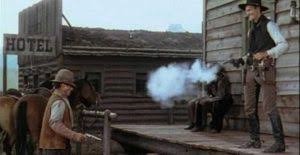
Of course, Torrey was murdered, but Wilson killed him legally because it was Torrey who drew (or tried to draw) his gun first…in front of witnesses. This was the “stand your ground” law that still exists in many states in America and is probably still the cause of many gun deaths in the country. It was the same reason Jimmy Ringo could not have been arrested for killing Eddie in The Gunfighter. A man was entitled to defend himself.
As I have already said, this made it extremely difficult to prosecute anyone for murder because they almost always claimed they killed in self-defense. It is this strategy Riker plans to use to terrorize the homesteaders. Having failed to bribe Starrett into working for him, Riker is now willing to resort to this form of legal killing.
Part 5 – The homesteaders have come together at Torrey’s funeral to say farewell to their friend and to offer comfort to his widow and children. Mrs. Torrey would now be in an almost hopeless situation; a woman alone with young children. That is difficult enough in our own time, in the old west it might mean she and her children would starve to death…unless…unless there is a community of people to help them. That is what civilization offers. When I was a young child my father taught me that the standards by which we should judge a society were by how it treats its weakest and most unfortunate members. A society that would let Mrs. Torrey and her children starve is a bad one, while a society that helps them to survive is a good one. What do you think about that idea?
But this tiny society of farmers in the valley is about to fall apart. Their attempt to build a community has failed because they are being terrorized by violence. They are ready to give up. But then, someone speaks out. It is once again the stubborn farmer Joe Starrett.
Part 6 – Just as I said, a society can be judged by how it treats its weakest members. The Rikers have just burned down the Lewis’s house. Even if they choose to stay in the valley, the Lewis’s would be homeless. But this society…tiny and poor as it is…will not allow that to happen. Inspired by the courage and determination of Joe Starrett and Shane they promise that they will all join together to rebuild the house. I am also certain they will help Mrs. Torrey and her children. By helping those who need help, they are creating a stronger community. By sticking together and helping each other, they find new courage to stay in the valley. But they aren’t fools. They know Riker will use violence and they want to know what Starrett proposes to do about it. But you will have to wait until the next lesson to find out.